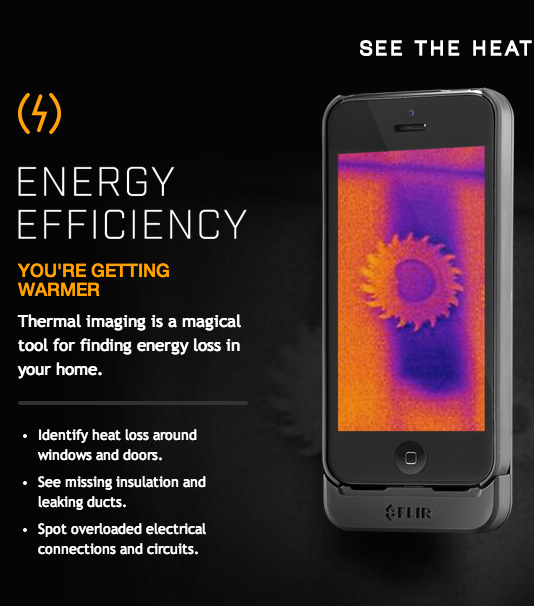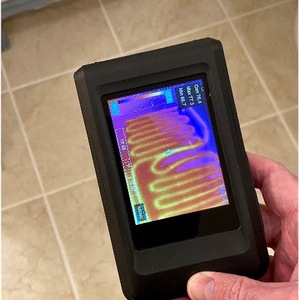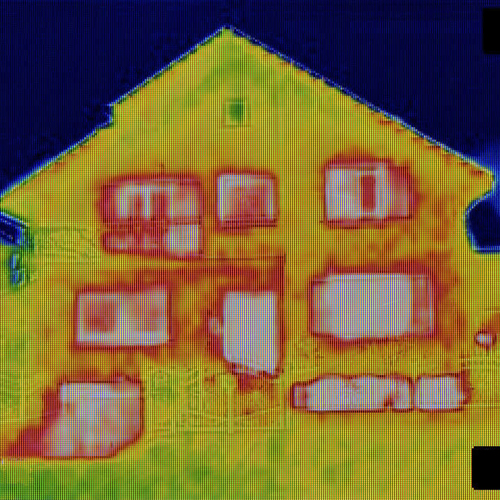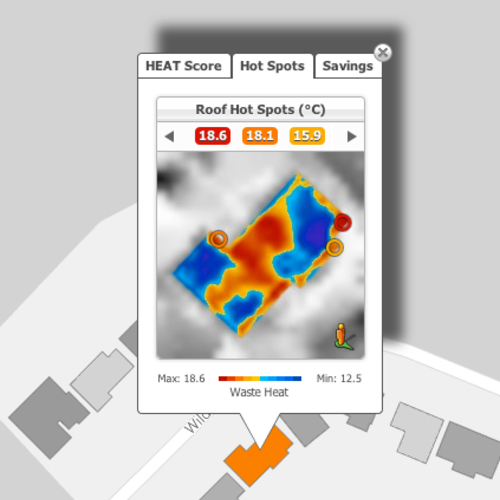
An Oregon company has introduced a $349 gadget that turns an Apple iPhone into a thermal imaging device capable of detecting heating and cooling leaks in buildings.
Flir introduced the Flir One at the Consumer Electronics Show in Las Vegas on January 7. The company said it would start selling the device worldwide this spring. The Flir One fits on an iPhone 5 or iPhone 5S, the most recent models.
A Flir-equipped iPhone displays an image showing heat rather than visible light, so it can show heat loss through walls or around windows. That could help builders and remodelers see areas where insulation or air-sealing need to be improved. Among other uses, the company said, are spotting water damage and detecting intruders at night.
The device has its own rechargeable battery good enough for two hours of operation, and it boosts the iPhone’s battery life by as much as 50%, the company says.
Flir, based in Wilsonville, Oregon, said that the thermal imager is the first of its kind designed specifically for consumers. Pro models can cost thousands of dollars.
Its exact specs haven’t been published
David Meiland, a builder in Washington State and a frequent contributor to Green Building Advisor forums, said that Flir is a “dominant” manufacturer of infrared equipment. But he cautioned that an imager in this price range may not have the resolution or thermal sensitivity of more expensive devices, so its usefulness would be somewhat limited.
Meiland, who has been using an $8,000 Fluke imager for the last four years, says there are times when detecting temperature differences of as little a .05 degree Celsius are important. But in other situations, measuring minute temperature differences wouldn’t be critical. Suppose, for example, that a builder suspects that a hidden heating duct has split, spilling warm air into a wall or ceiling cavity. “In those circumstances, low resolution and a slow processor and a small image would probably give you the same result,” Meiland said.
Flir posts the range of temperatures that the One will detect, but not the temperature sensitivity — the minimum difference in temperature in adjacent surfaces that would appear in the image. Nor does the website list the resolution of the image. The Flir sales office in Boston said it didn’t have the information, and that technical inquiries would be handled by e-mail.
As useful as thermal imagers can be in tracking down elusive information about buildings, Meiland said they’re not magical. “The real issue with infrared is getting an incorrect diagnosis,” he said. “It’s really easy to look at something and say, ‘Oh, here’s what’s going on.’ And then you check it with other tools and you realize, ‘Wait, that isn’t what’s going on. There’s more going on.’ You can get all kinds of incorrect conclusions out of infrared. That’s where the risk is. Sometimes I still have to get out a Sawzall, look inside the wall.”
If you want to read more about thermal imaging, read this blog by GBA senior editor Martin Holladay.
Weekly Newsletter
Get building science and energy efficiency advice, plus special offers, in your inbox.















11 Comments
Things are heating up
There have been two very successful fundraisers for smartphone IR cameras lately:
The first one had a $20k goal and raised $195k in January 2013: http://www.kickstarter.com/projects/andyrawson/ir-blue-thermal-imaging-smartphone-accessory/posts . Units have shipped and they work, although the unit seems to have its share of frustrations.
The second one had a $200k goal and raised $282k in March 2013: http://www.indiegogo.com/projects/mu-thermal-camera-a-great-tool-to-save-on-energy-costs . They appear to be nearing completion on manufacturing of the devices.
Both had "early backer" specials for $150-200, and the Mu claims an MSRP (differing in a couple places) of $325-400.
It's great to see Flir jumping in, when there is obviously some demand for these devices. I'd like to see Android support from them. I've been frustrated by the price of IR camera rentals, and buying one is currently a $1000 endeavor, at the very least. Seeing that slashed to one-third is very encouraging.
Thermal sensitivity
I may not have been clear enough when I talked to Scott about this. The thermal sensitivity of typical high end models for building inspection is .05C, not .5C. I don't know what the specs on this Flir are.
Response to David Meiland
David,
Thanks for catching our error; I appreciate it. I have edited the text of the article to reflect your correction.
I phone IR
I will be in the market for one of these (maybe)
I do want to see what the spec are.
This will make a nice toy and possible tool for marketing my (real) camera and its usefulness.
Could've been my error, Martin...
... but thanks.
Here is a spec sheet I found on another site. Click on it to make it readable.
Flir One specs
Let's see if this is clearer.
Can't get there with visible-light optics( for Mark Parlee)
You "real" camera can't deal with the deep-infrared necessary for imaging stuff anywhere near as cool as 270 Kelvin. The reason it's $350 is primarily the the specialized optics. Clever resistor-array
imaging technology has take a huge cut out of the cost of IR imaging elements- prior to the late '90s it used to require cooling the imagers to cryogenic temperatures to be able to do much with them for detecting temperature differences relevant for house inspections. Flir is an industry leader, with a great depth of engineering prowess in imaging & temperature profiling in the deep infra-red. I'd trust them to get the optics and temperature calibration right more than some of the competition.
The Mu-optics camera in imaging element in Nick Welch's second link is pretty lo-res at 120 x 160, I'm wondering how the Flir toy compares. (I'm sure it's not 1020 x 480 like your TV, but it's nice to have an image with a bit better pixel granularity than that.)
Full disclosure: Through my own company I worked as a contractor to Inframetrics back in the 1990s, prior to their being acquired by FLIR (and briefly after that event.) I also get involved with designing infra-red imaging systems in the near-visible range for other applications unrelated to temperature sensing- maybe I've been spoiled by the higher-res stuff. :-)
emissivity
Don't forget the emissivity setting
The IR sensor
Dana, I didn't read it that Mark was suggesting an ordinary camera modified for IR, but instead he could use a low cost "toy" as a demo.. helping to convince potential customers why the use of the better thermal camera might be useful...
I suspect some of the new low cost devices are using the Ulis-ir sensor... they've have a family of products that look like they are aiming for automotive applications -- fast responding, and the ability to spot cars, people, etc on the side of the road -- at night... no lights. The sensors have the correct spectral range for building uses....and it might be possible to chill the chip and improve sensitivity..
The article mentions thermal sensitivity... it is worth remembering that doesn't mean accuracy. It's about the noise level... Dana can explain that a lot better.
Dana, years ago.. now perhaps 25... I had chance to use one of the Inframetrics camera... I believe it had a little sterling chiller built into it...
Resolution
Flir commented on a Facebook post, not too long ago indicating that the resolution of the camera is 80x60, however when combined with a digital image, looks more like 320x240 (and some people at CES even thought it looked as good as a 640x480 thermogram!)
FLIR releases specs
At the time this was first posted, FLIR had not released some of the details about this device. More recently, the company sent an email with the following information:
Resolution: 80x60.
Thermal sensitivity: 100mK NETD (mK is milliKelvins; the lower the number the higher the resolution).
Manual or auto focus: Auto.
Image transfer: Device connection jack.
I emailed David Meiland the information, and he offered a few thoughts. In practical terms, he says, a 100mK imager can detect differences in temperature of 0.1 degrees C. Better imagers, he adds, can detect differences of 0.05 degrees C (this would be a 50mK imager).
If you want to read more about the NETP, or Noise Equivalent Temperature Difference, Meiland sent a link to an article that includes an explanation.
He adds that 80x60 is a "small detector array." A 160x120 is a good size, he says, and common on imagers costing a couple of thousand dollars.
Log in or create an account to post a comment.
Sign up Log in